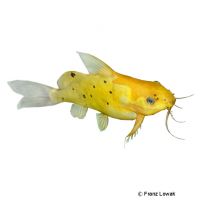Golden Common Synodontis (Synodontis nigrita 'Gold')
| Golden Common Synodontis Synodontis nigrita 'Gold' | |
|---|---|
| Name | Golden Common Synodontis |
| Name Lat. | Synodontis nigrita 'Gold' |
| Family | Upside-down Catfishes |
| Family lat. | Mochokidae |
| Order | Catfishes |
| Order lat. | Siluriformes |
| Origin | Africa |
| Habitat | Rivers, lakes |
| Diet | Omnivore |
| pH | 6.0-7.5 |
| Behavior | Nocturnal, peaceful |
| Keeping | Individual, group |
| Care Level | Moderate |
| Reproduction | Egg scatterer |
| Breeding | None reported |
| Life Span | 10-15 years |
| Protection | No |
| Metric Units | |
| Size | 20 cm |
| Temperature | 21-26 °C |
| Hardness | 3-20 °dH |
| Aquarium | 320 l |
| US Units | |
| Size | 7.9" |
| Temperature | 70-79 °F |
| Hardness | 53-356 ppm |
| Aquarium | 85 gal |
Distribution and habitat
The Featherbeard Catfish Gold is a color morph of Synodontis nigrita. The crepuscular and nocturnal Black Featherbeard Catfish are widespread in Central and West Africa. They live in lakes and slow-flowing rivers with riparian vegetation, where they spend most of their time during the day under roots or in stone caves.
Maintenance
They require an aquarium with dense planting, with plenty of hiding places such as stone caves (e.g. perforated rock) and roots A sandy dark substrate and subdued light (floating plants) is ideal.
No ammonia, ammonium and nitrite should be detectable, the nitrate value should not exceed 100 mg/l. To ensure the water quality and oxygen content, a filter and heater adapted to the aquarium size is required, as well as lighting for the species-appropriate day-night rhythm of the animals.
Diet
They are easy to feed and will accept any type of live or frozen food, such as daphnia, cyclops, mysis, artemia and black mosquito larvae, as well as dry catfish food (granules, flake and tablet food). In addition, they need regular vegetable food, such as crushed peas, cucumber slices, mashed leafy and wild vegetables or dry food with high vegetable content (spirulina, kelp)
A regular and varied diet promotes health and prevents deficiency symptoms. Only feed as much as is eaten immediately (in a maximum of 10 minutes).
Behaviour and compatibility
Older animals sometimes behave intra-species territorial, therefore several animals should be maintained only in large and richly structured tanks. Towards other, not too small fish, they are peaceful and can be socialized well with them
Basically, only compatible fish species with similar demands on water condition and water temperature should be socialized.
Sex dimorphism
The males are more slender than the females. With some experience, the sexes can be determined by the shape of the genital papilla, which is pointed in the male and round in the female.
Reproduction and breeding
There are no known reports of successful breeding in the aquarium.
Important
During the day they usually stay under roots, in caves or under stones, often with their belly up.
When catching them, use as fine-meshed nets as possible to prevent the hard rays of the pectoral and dorsal fins from getting caught, which can cause painful stinging injuries when touched.
The well-being of the fish should be checked regularly. Temperature should be checked daily, pH, hardness and nitrate levels at least every 14 days. Regular partial water changes are recommended, even when contaminant levels have not yet reached the upper limit. Sudden changes in water quality should be avoided. Newly introduced fish must be accustomed slowly to the water in the aquarium.
Further literature can be found in your pet store.
References
Text: petdata; Image: Franz Lowak
Source: BMELV (1998): Tierschutzgutachten - Haltung von Zierfischen (Süßwasser); BAENSCH & RIEHL (2004): Aquarien Atlas Bd. 2, Mergus Verlag; ENGELMANN (2005): Zootierhaltung - Tiere in menschlicher Obhut: Fische, Verlag Harri Deutsch
- Gemäß § 21 Abs. 5 Tierschutzgesetz idgF
